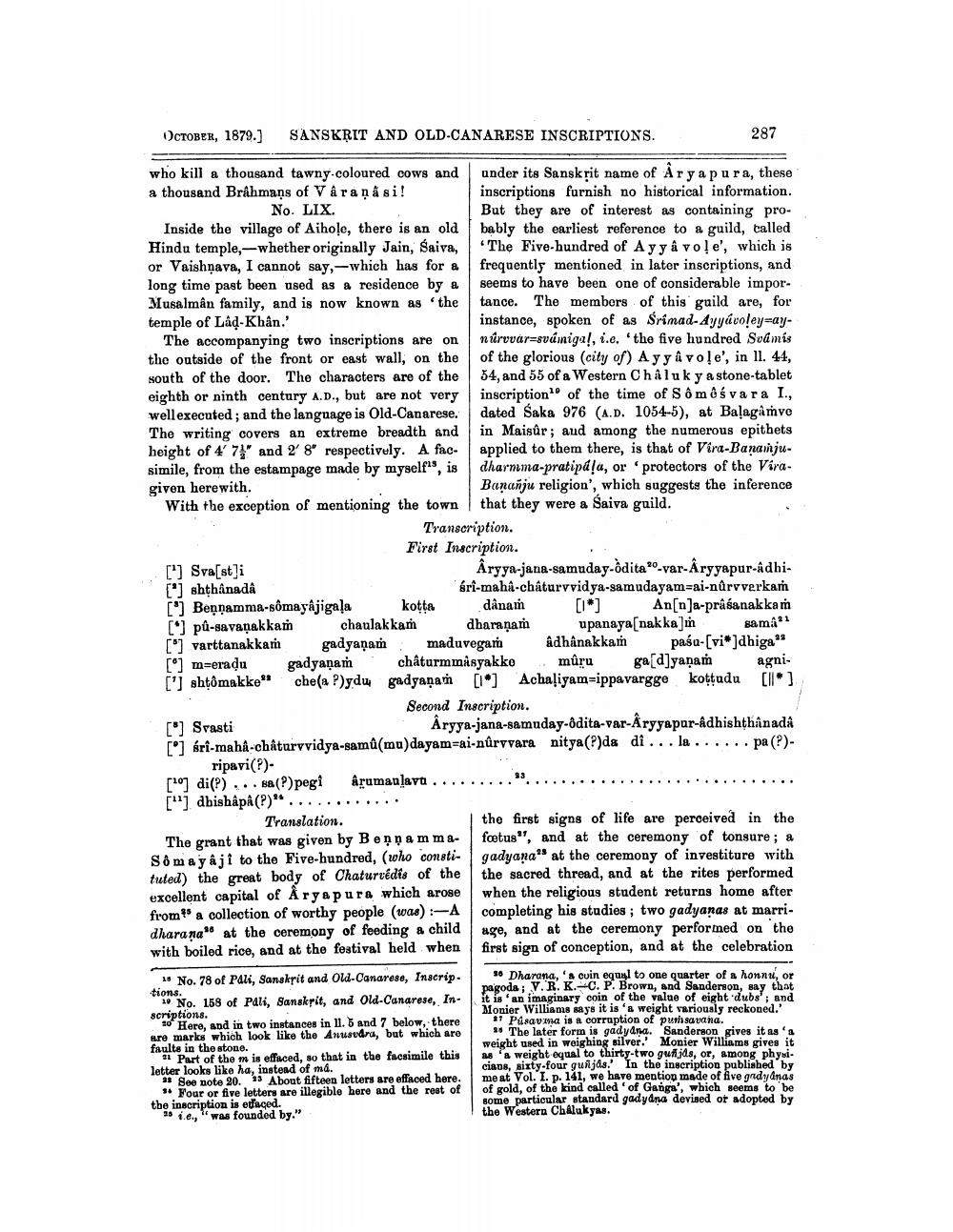________________
OCTOBER, 1879.] SANSKRIT AND OLD-CANARESE INSCRIPTIONS.
who kill a thousand tawny-coloured cows and a thousand Brahmans of Varanasi! No. LIX.
Inside the village of Aihole, there is an old Hindu temple, whether originally Jain, Saiva, or Vaishnava, I cannot say,-which has for a long time past been used as a residence by a Musalmân family, and is now known as 'the temple of Låd-Khân.'
The accompanying two inscriptions are on the outside of the front or east wall, on the south of the door. The characters are of the eighth or ninth century A.D., but are not very well executed; and the language is Old-Canarese. The writing covers an extreme breadth and height of 4' 7" and 2' 8" respectively. A facsimile, from the estampage made by myself, is given herewith.
With the exception of mentioning the town
['] Sva[st]i
[*] shṭhânadâ
[Beppamma-simaykjigaļa
[] pû-savanakkam
[] varttanakkam gadyapa
Transcription.
First Inscription.
koṭṭa
chaulakkam
[*]
dânam An[n]a-prâsanakkam dharaṇam upanaya[nakka]m sama21 maduvegar âdhânakkam pala.[vi]dhiga" mûru ga[d]yanamh
agni
[*] m=eraḍu gadyanam châturmmisyakke ['] shtômakke" che(a ?)ydu gadyanam [*] Achaliyam-ippavargge koṭṭudu [*]
Second Inscription.
[*] Svasti
Aryyn-jana-samuday-bdita-var-Aryyapar-Adhishthinad
[] árî-mahâ-châturvvidya-samû (mu) dayam-ai-nûrvvara nitya(?)da di... la...... pa (?). ripavi(?).
[10] di(?)... sa(?) pegi krumanlarn [] dhishâpâ(?).
287
under its Sanskrit name of Aryapura, these inscriptions furnish no historical information. But they are of interest as containing probably the earliest reference to a guild, called The Five-hundred of Ayy â vole', which is frequently mentioned in later inscriptions, and seems to have been one of considerable importance. The members of this guild are, for instance, spoken of as Srimad-Ayyavoley-aynúrvvar-svámiga!, i.e. the five hundred Svamis of the glorious (city of) Ayyavole', in ll. 44, 54, and 55 of a Western Châluky a stone-tablet inscription of the time of Sômôśvara I., dated Saka 976 (A.D. 1054-5), at Balagamve in Maisûr; aud among the numerous epithets applied to them there, is that of Vira-Banaijudharmma-pratipala, or protectors of the ViraBananju religion', which suggests the inference that they were a Śaiva guild.
Aryya-jana-samuday-bditavar-Aryyapar-idhiári-mahi-chaturvvidya-samudayam-ai-narvverkah
Translation.
The grant that was given by BennammaSomayaji to the Five-hundred, (who constituted) the great body of Chaturvedis of the excellent capital of Aryapura which arose. from a collection of worthy people (was) :-A dharana" at the ceremony of feeding a child with boiled rice, and at the festival held when
18 No. 78 of Pali, Sanskrit and Old-Canarese, Inscriptions.
19 No. 158 of Pali, Sanskrit, and Old-Canarese, Inscriptions.
20 Here, and in two instances in 11. 5 and 7 below, there are marks which look like the Anusedra, but which are faults in the stone.
Part of the m is effaced, so that in the facsimile this letter looks like ha, instead of må.
23 See note 20. 23 About fifteen letters are effaced here. Four or five letters are illegible here and the rest of the inscription is etfaced.
25
i.e., was founded by."
the first signs of life are perceived in the foetus", and at the ceremony of tonsure; a gadyana" at the ceremony of investiture with the sacred thread, and at the rites performed when the religious student returns home after completing his studies; two gadyanas at marriage, and at the ceremony performed on the first sign of conception, and at the celebration
so Dharana, a cuin equal to one quarter of a honnu, or pagoda; V. R. K.-C. P. Brown, and Sanderson, say that it is an imaginary coin of the value of eight dubs'; and Monier Williams says it is 'a weight variously reckoned.' 27 Púsavma is a corruption of pushsavana.
2 The later form is gadyana. Sanderson gives it as 'a weight used in weighing silver.' Monier Williams gives it as a weight equal to thirty-two guñjas, or, among physicians, sixty-four gunjas. In the inscription published by me at Vol. I. p. 141, we have mention made of five gadyanas of gold, of the kind called ' of Ganga', which seems to be some particular standard gadydna devised or adopted by the Western Chalukyas.




